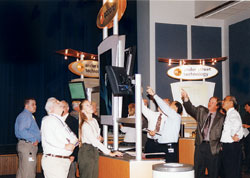...issues, including the use of regional transmission organizations to operate grids, and guarantee a sufficient rate of return to attract capital.
But there is also growing attention to use of the ITC model in which the local transmission grid is spun off as a separate utility regulated solely by FERC and gets a high return in its rate because it is independent and not part of a larger utility.
In Michigan, after the Detroit Edison grid was sold to International Transmission Co. of Novi, Mich., in 2003, the company immediately embarked on an $83-million drive to upgrade the system to relieve congestion. We are a transmission-only business and we dont have much of a calling card if our system isnt the best in class, says Joe Welch, president and CEO of International Transmission.
|
On the siting front, the biggest change facing industry is the increased interest in putting lines underground, especially in suburbs. Currently 20% of the national grid is underground, mainly in dense urban areas, and contractors report a steady increase in underground work. Its inherently more costly, so it produces more revenue. Also, its more expensive to fix when an outage occurs. The practice of undergrounding transmission lines already is relatively common in parts of Western Europe and Asia, especially in and around densely packed cities.
Installing lines of 69 kV or more underground poses a variety of technical challenges, can pose reliability problems from conductor-heat buildup and underground water buildup, and typically costs several times as much as much as traditional overhead lines.
But undergrounding may be the only feasible alternative in heavily urbanized areas and to connect mainland and island electric systems. Its increasingly being considered to eliminate the visual impact of overhead lines in scenic and environmentally sensitive areas.
South of Boston, for example, NSTARformerly known as Boston Edisonis seeking approval from the Massachusetts Energy Facility Siting Board to install an 18-mile-long, 345-kV underground transmission line from Stoughton to South Boston by mid-2006, at a pace of about 100 ft per day.
 |
 |
| ANTI-NIMBY Utilities win public support with local information meetings. (Photo top courtesy of Burns & McDonnell; bottom courtesy of Northeast Utilities) |
Mark Reed, NSTAR director of public affairs, says NSTAR is very confident that the $170-million line, whose three circuits will be encased in oil to keep them cool and placed within concrete-filled trench, will operate reliably. The plan to underground the line has significantly reduced local opposition to the proposal, he adds. A public hearing on the plan is scheduled for May 6, and NSTAR hopes to secure the siting board's okay late this summer and start construction this fall.
Near Canada's Banff National Park in Alberta, SNC Lavalin ATP Inc.a wholly owned subsidiary of Montreal-based SNC Lavalin Groupwill be designing and installing a double-circuit 138-kV underground line through the scenic Three Sister Mountain Village area.
The $10-million-plus, 2.6-mile line, which is expected to be completed by October 2005, will replace two overhead circuits. Cindy Andrew, vice president at SNC Lavalin ATP, said in a written statement that construction will be challenging because the line's route runs through mountainous terrain housing abandoned shallow mineshafts and sinkholes.
She added, Portions of the concrete-filled trench that contains the power cables will be under streams and standing water, while other sections will have to be self-supporting to span the sinkholes and mineshafts. SNC Lavalin ATP noted that the Banff-area project will require the installation of five double-chamber splicing vaultsunderground chambers where the underground power cables are joined, and where inspections and maintenance can be carried out.
Over the longer term, however the biggest change in transmission contracting is likely to be the changeover to electronically controlled systems that will reduce the need for new lines.
The problem with smart grid is the high cost and the reluctance of utilities to trust their high-voltage systems to new, unfamiliar systems. In the end they will go to solid-state technology because the old systems need to be replaced, says Tripp.
